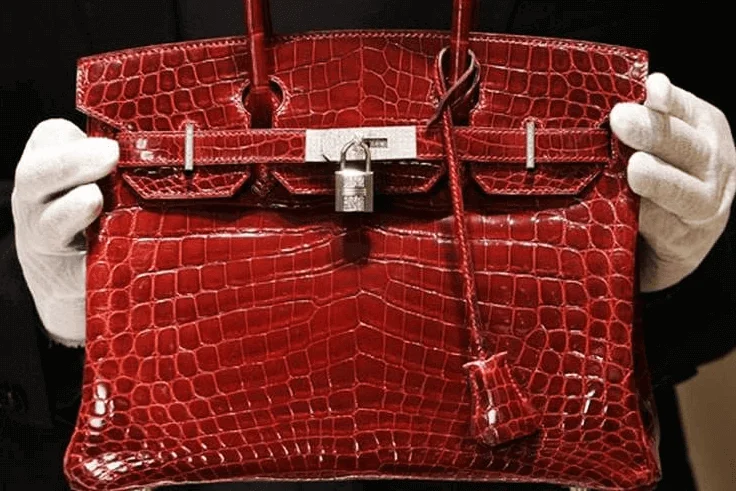
When you’re about to buy leather purses for women in the market, what do you look for? Is it the price tag, quality and overall appearance? Or is it appearance, price and quality? Or do you prioritise quality the most? Each buyer differs in the importance they attach to each of these criteria.
And today’s production market has divisions catering to each of these segments in the consumer market. On one hand, you have brands like Aldo, Guess and Charles and Keith producing faux leather purses for women who are economically stringent buyers. Then there are Coach, Kate Spade and Michael Kors for those who’d like to buy leather purses for women and are willing to shell out more than a few hundred bucks for them.
For the bags on the other hand of the price spectrum, however, the sky is the limit. Called the Holy Grail trio of handbags, Hermès, Chanel and Louis Vuitton compete with each other in price, regularly releasing leather purses for women costing over $10,000. But even amongst them, Hermès has the upper hand. Its secret? Premium, handmade leather bags.
In fact, the world’s most expensive and luxurious items still feature handmade components. From German sports cars to the finest Italian leather purses for women, handcrafted goods cost a lot more owing to the hours of labour that goes into them.
Add to that the fact that Hermès has actually been developing handmade leather items, renowned for their exquisite craftsmanship, since 1837. It was founded by Thierry Hermès as a harness workshop exclusively serving European noblemen – even Napoleon Bonaparte was one of its clients!
Even today, it continues to specialise in exquisite leather goods. From skateboards to the inside of the Aston Martin DB4 sports car to boxing gloves, the Hermès artisans working in their Le Sur Mesure workshop can do it all. These craftsmen are also the creators of the exquisite Hermès rickshaw owned by the Four Seasons Hotel in Kyoto, Japan. Another whimsical piece by Hermès? This fruit-shaped lambskin leather purse for women crafted around a hard silver shell is made to hold your daily apple!
It’s true! Hermès’ creative genius commands presence everywhere! But its biggest achievement, undoubtedly, is in making leather purses for women, a sector it entered in 1922.
Popular Purses of Hermès
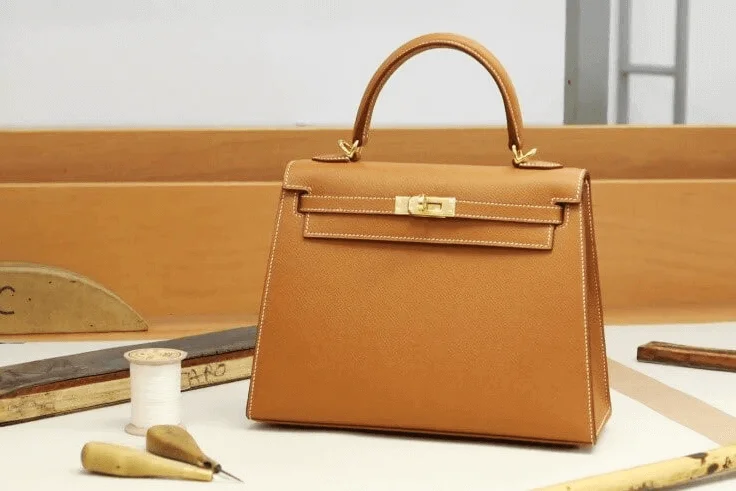
The Kelly Bag: One of today’s most famous Hermès leather purses for women was devised by Émile-Maurice, the head of the company, when his spouse complained there were no luggages to her liking. Hence, the Sac à Dépêches was released in 1935. It was later renamed the Kelly bag after actress Grace Kelly, the Princess of Monaco, in 1977.
The Constance: Hermès has always been known for its equestrian (saddle-making) origins. So, the Constance, featuring the enduring saddle-bag design, was developed in 1969.
The Birkin Bag: By far the most well-known bag, the Hermès Birkin handbag was introduced in 1986. The story goes that after an opportunity face with a flight with Jane Birkin, who immediately after asserting she could not locate a bag to accommodate her wants, compelled Hermès Main Executive Jean-Louis Dumas to design and style her a gentle, supple day-to-day bag.
In fact, the success of the Birkin shot Hermès to the “star” status it enjoys today. The bag is the ultimate “must-have”, between both celebrities and bag-loving women. All the other luxury brands want to replicate the success and have their range of Birkin-inspired bags!
So, why are Birkins Special?

“It’s genuinely a combination of the craftsmanship and the quality of Birkins which make them so coveted,”
explains Sophie Hersan, co-founding father of Vestiaire Collective.
“Each Hermès Birkin handbag is made by a single person. Plus, the leathers are selected incredibly meticulously to make sure that only the best items are used. The attention to element is outstanding, and only adds to the desirability of the baggage.” (Source: Brand Design)
In fact, a recent study by Baghunter discovered that price of an Hermès Birkin handbag has outdone the price of both gold and stocks over the past 35 years. An Hermès Birkin handbag has an annual return of 14.2%. In comparison, the average on S&P 500 stocks is 8.7%. (Source: Lifestyle Asia). In 2019, Christie’s sold the most expensive bag ever, a Niloticus Crocodile Himalaya Hermès Birkin handbag with white gold hardware studded with 18 carat diamonds for a record $500,000!
No wonder all brands want a piece of the Birkin!
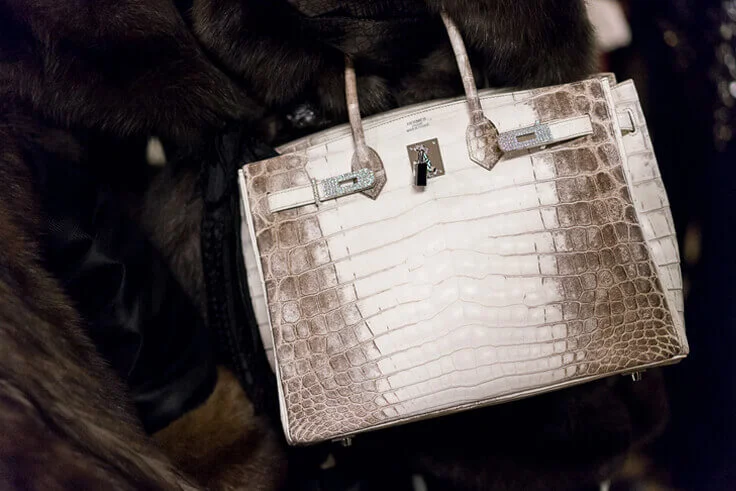
Not only that, if a Birkin is very much used, Hermès offers exclusive repair services for its bags too!
“In the event the Hermès Birkin handbag is less than perfect after a long time of use, it can go the Hermès spa where it’s going to spend some weeks being brought back to its ideal condition, having its components and leather restored and polished.” (Source: Brand Design).
However, it isn’t just the highest quality leathers, exotic skins and embellishments that results in this astronomical price tag. It takes each craftsman (or craftswoman) a minimum of 18 hours to create one bag!
Furthermore, the artisans who craft these leather purses for women are carefully screened and require years of high-quality experience before even being considered for the job. Most of them are graduates from the École Grégoire-Ferrandi; a school that specializes in working with luxurious leathers. After that, these leather-crafters must train for a minimum of five years before they’re allowed to create a Hermès Birkin handbag on their own. Each Birkin is made by a single artisan — by hand — from beginning to end. Traditional saddle-making tools like awls, needles and pinces-à-coudre, large wooden grips are used in the process.
Another technique artisans need to master is the saddle stitch. This is a method in which an artisan pulls two needles through a hole in opposite directions. Every stitch is placed with the utmost precision, and doesn’t unravel when done properly. Once these leather purses for women have been stitched, the craftsmen polish the seams with beeswax for smoothening and rot-prevention.
Given the tremendous effort, the craftsmen feel a sense of ownership of the bags they create. Each Hermès Birkin handbag is marked with a code that denotes the year it was created, the workshop it originated from and the artisan who made it. If a customer needs to have their bag repaired? They can send their Birkin back to Hermès, where the bag’s respective artisan will mend it. All of the minute details, the hours of painstaking work and the years of training that go into a Hermès Birkin handbag prove why it remains one of the most coveted and counterfeited luxury items on the market. (Source: The Real Real)
How Handmade Leather Birkins are Produced:
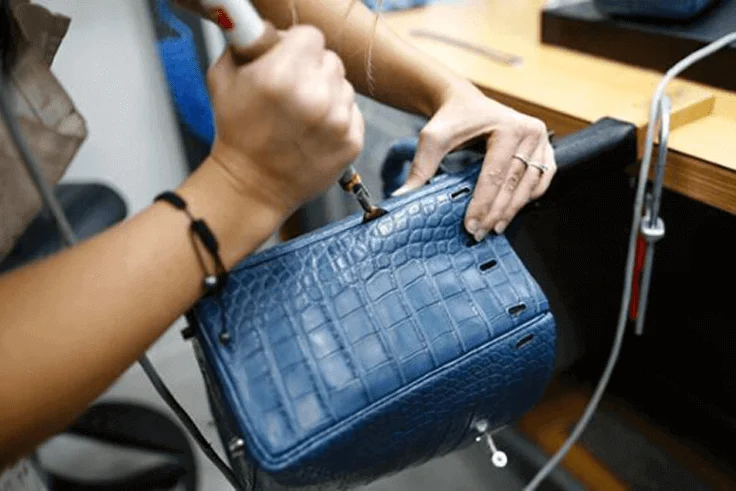
- The entire bag-making process starts with the leather cutter. Here, he inspects the crocodile leather to determine which pieces are ideal for an Hermès Birkin handbag.
- The leather or skin is first examined for any defects. All defects are marked with a white marker and are then removed. This is a tedious process that can take a couple of hours to complete. Mosquito bites and wounds on the animal become apparent once the skin has been tanned, making this an incredibly important step. Once the skin has been fully examined it gets cut, again using extreme caution.
- Many of the leathers, like the blue crocodile skin above, are dyed.
- Stitching the Hermès bag using the saddle stitch, while the skin is held together using a wooden clamp. Most Hermès bags are created with same-colour threads, but some rare bags have white threads even if the bag is not white. Double magnifying glasses help enhance the tiny stitches for the craftsmen.
- Once the stitching process is complete, the artisan then taps the seam with a hammer. This allows the seam to be less apparent. After tapping the seam with a hammer, the seam is then shaved, sanded and waxed. Ultimately, this provides a uniform look that makes it appear as though both leathers are the same.
- The chains for the handles of the bag are hand welded. The metal is made malleable in a bubbling bath and heated to extreme temperatures.
- Making the handle can take up to four hours. The handle is made from the exact same type of leather, but contains several layers of it. Most handles are made using 4 – 5 layers of leather. The artisan flattens it with a mallet and ensures the handle is smooth. He then uses his thigh to create the form of the handle and then places it on the bag with extreme precision.
- The hardware is then attached using the unique Hermès process called “Pearling” rather than by using screws. They use this process because traditional screws can loosen with time; the pearling process keeps the hardware in place forever. Some artisans prefer placing the hardware before stitching the bag. Once the hardware has been added, a clear plastic film is placed over it in order to prevent the metal from getting scratched or damaged. This film often remains on the hardware until the bag is delivered to the person who purchases it.
- Once a Hermès bag is complete, the inspection process is thorough. A workshop inspector will go over every little detail of the bag in order to ensure that it’s up to Hermès standards. If the bag passes the initial inspection, it gets stamped. The stamp allows Hermès to identify the artisan who made the bag, the workshop where it was created and the year. From there, the bag Hermès Birkin bag gets sent to the Hermès logistics department in the town of Bobigny. This is where the final inspection will occur. If the bag passes this final inspection, it gets packed in the signature orange box and sent out to one of the Hermès boutiques around the world. If any imperfect bags are found, they are normally destroyed. Hermès does not risk having an imperfect bag on the streets. (Source: BagHunter)
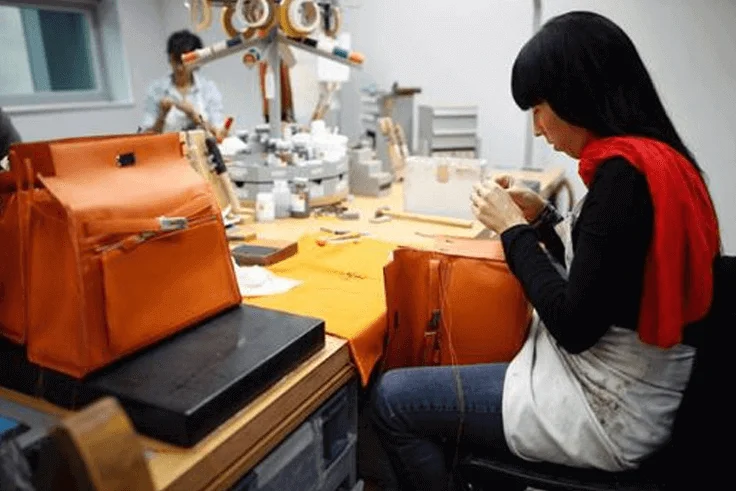
Wait, Where Does Bangladesh Come In Here? Handmade Leather Goods?
Initially, Pantin, a quaint town just north of Paris’s 19th arrondissement, housed the only Hermès workshop focused on creating the signature leather tote. It was one of the four across France; other locations include Ardennes, Lyonnais and Lorraine. Recently, it has opened a new manufacturing plant in eastern France, as rivals like Louis Vuitton also expand leather goods production to keep up with thriving Chinese demand. However, in the fourth quarter of 2017, Hermès’ sales growth slowed slightly from the previous three months as stocks of its handbags ran low. So now, it plans to open its 16th leather goods workshop, located in the country not far from the city of Mulhouse. This facility would house 260 specialists trained to hand-craft a bag from start to finish. Usually, Hermès tends to pick sites in rural areas for its plants, hiring locally and training staff-in house, for workshops of around 300 people maximum.
And Bangladesh serves as a potential opportunity for designers like Hermès to expand operations. Why?
Bangladesh’s geographical location, in the south-eastern part of the Indian subcontinent where the Ganges basin drains fertile alluvial soil and green vegetation is luxuriant, makes for the most suitable conditions for high-quality animal hides. These are the exact conditions Hermès prefers when setting up its farms exclusively for the supplying to its workshops. Bangladeshi leather has already gained acclamation around the world for its high-quality fine grain leather, uniform fibre structure, smooth feel and natural texture, all of which are crucial in giving the Birkin its luxurious feel.
Not only that, as we have witnessed previously, the Bangladesh leather industry is set to make a significant comeback post the COVID-19 pandemic. Add to this the fact that certain leather goods manufacturers have started focusing on specialising in handmade accessories in Bangladesh. Arfin, which is a purveyor of luxury handcrafted shoes, and Lidia May, which features the traditional handloom Jamdani pattern on handmade leather totes and purses, are testaments to that. So, conditions are ripe for Hermès to benefit from the abundant resources Bangladesh has to offer.

Actually, there a number of luxury leather bag-makers besides Hermès who may potentially reap the advantages of producing in Bangladesh, like Bottega Veneta, Mulberry and Métier London. Even mainstream designers, such as Louis Vuitton and Gucci, have their separate handcrafted range of leather purses and accessories which, as can be easily guessed, retail for much more than their machine-made, mass-produced counterparts. And Bangladesh is all the more lucrative for these houses owing to its booming leather industry and specialization in handmade leather goods.
But even for manufacturers not affiliated with premier designers, the promise of producing their range of leather bags in Bangladesh has several advantages. As discussed above, handcrafted purses are the ultimate bespoke luxury, creating room for designers to charge much higher and differentiate their products organically. Taking the handmade route has many more advantages, as outlined below:
- Long-lasting. Excellent Build Quality – when comparing handmade leather to machine-made leather, smaller details will be evident. A bag made of handmade leather will typically last far longer than one made by a machine. Superior build quality means greater resistance to wear and tear too.
- Feel – Machine-made leather goods use stiffeners and other chemical agents to treat the leather, which compromises its quality. On the other hand, handmade leather goods use a more natural production method that gives the product time to breathe while being constructed. True leather is soft and malleable and gives way under the pressure of our fingers, forming small creases which can be hardly imitated by synthetic materials. Handmaking bags preserve this appearance.
- Truly Bespoke – Leather, being a natural fabric, can never be perfectly homogeneous. It will be easy to notice small differences in tone and colour, not only between different bags, but also within the same product. These are small variations that guarantee the genuineness of materials used. Handcrafted leather pieces further offer custom designs (like Birkins) that allow you to choose bags that match your tastes and preferences. In that scenario, it is impossible for an artisan to produce identical items. This means that each product is slightly different and, thus, unique. This is an added value, especially in a world where nearly everything is mass-produced.
- Cost-effective – The long-life characteristic of leather products saves you from the hassles of repeated purchase of low-quality bags. Protective cream and leather conditioner helps to preserve the fresh look of leather for years to come.
- Timelessness – The real test will be given with time, because leather bags, handmade bags, good quality bags, truly last a lifetime. Furthermore, they improve with time, much like those ladies, a little aged, who continue to maintain an innate elegance which is difficult to describe!
- Eco-friendly – Full-grain leather does not utilize any chemicals for its production. Vegetable tanning contributes immensely to the strength of the leather produced. The natural substances used in the production are safe and sustainable for the environment.
- The core concept of sustainability is “meeting the needs of this generation without compromising the needs of future generations”. And handmade leather handbags have the potential to be a sustainable source of earning, for manufacturers, designers and consumers alike. And all this is besides the immense fashion appeal of handmade bespoke bags, facilitated by the rise of the Birkin. These factors pose Bangladesh as a lucrative prospective destination for designer houses to opt for introducing or sourcing handmade leather purses. Furthermore, in Bangladesh, the movement for sustainability by boycotting factories is actually economically damaging. This is true especially in the context of small and medium factories. Instead, effecting a gradual shift towards handmade leather is significantly more sustainable and impactful.
The core concept of sustainability is “meeting the needs of this generation without compromising the needs of future generations”. And handmade leather handbags have the potential to be a sustainable source of earning, for manufacturers, designers and consumers alike. And all this is besides the immense fashion appeal of handmade bespoke bags, facilitated by the rise of the Birkin. These factors pose Bangladesh as a lucrative prospective destination for designer houses to opt for introducing or sourcing handmade leather purses. Furthermore, in Bangladesh, the movement for sustainability by boycotting factories is actually economically damaging. This is true especially in the context of small and medium factories. Instead, effecting a gradual shift towards handmade leather is significantly more sustainable and impactful.
